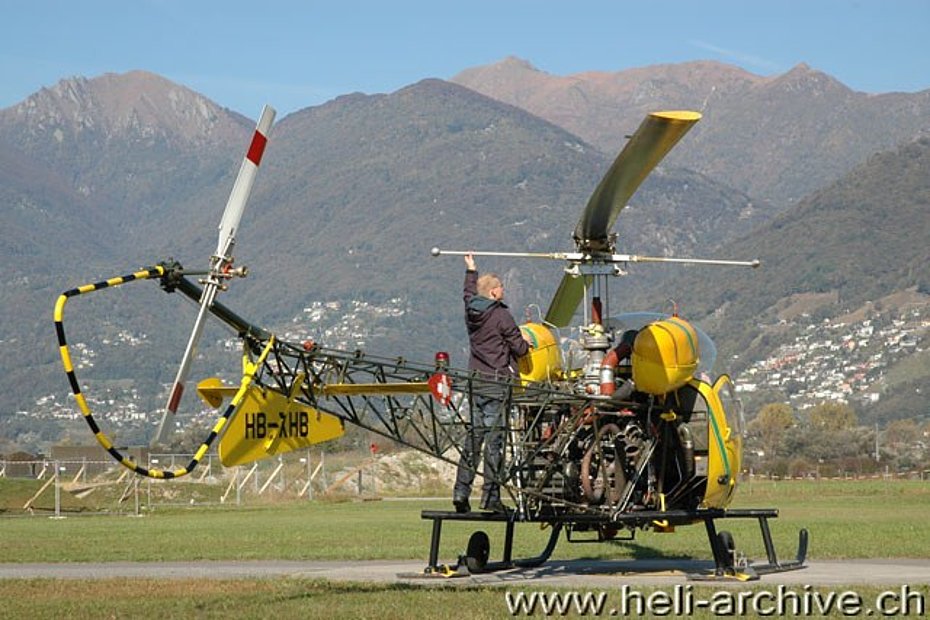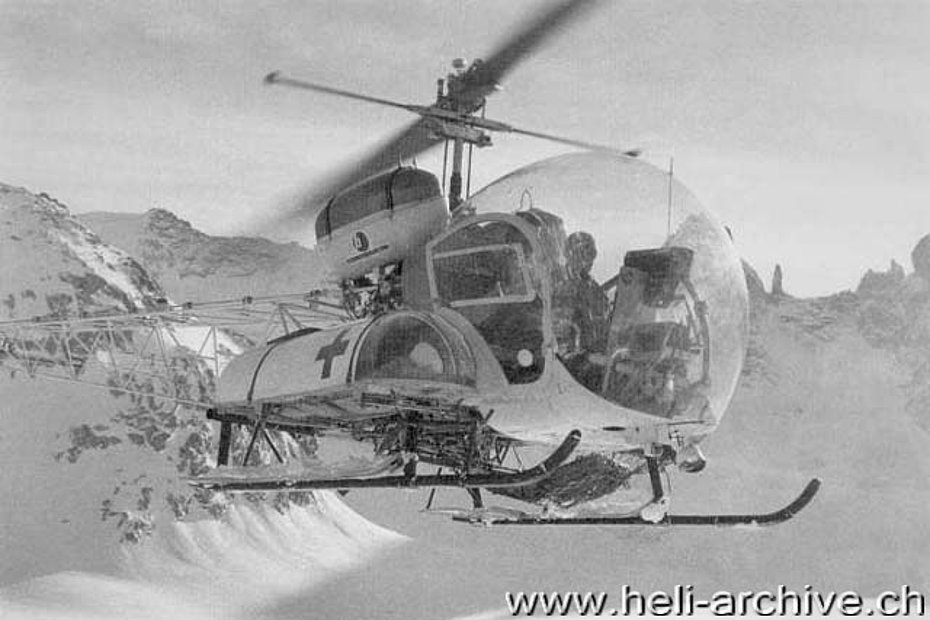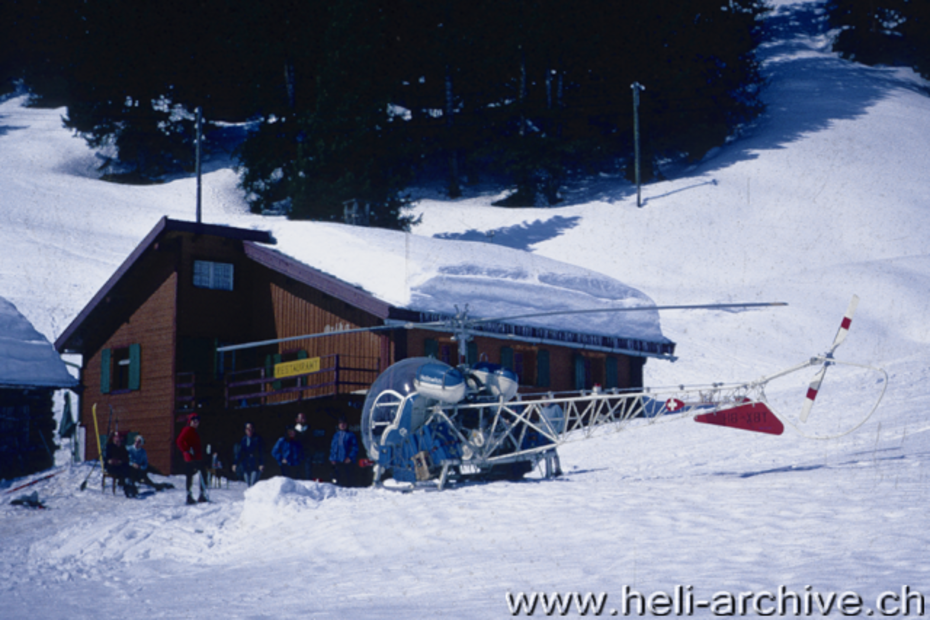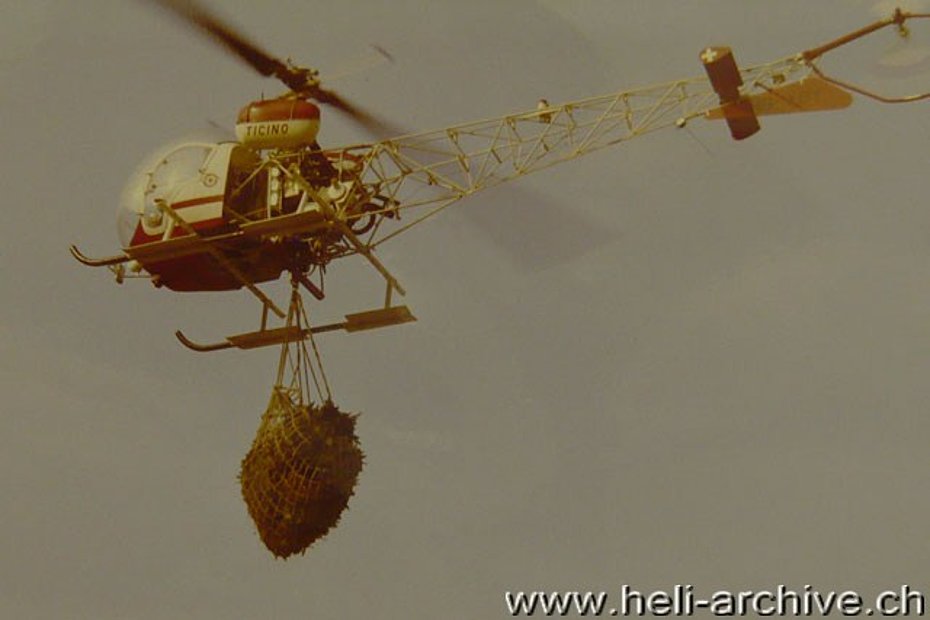
Bell 47G3B-1 - History and technical description
Some historical notes
The Bell 47G3B-1 (or Bell 47G-3B-1) designed and manufactured by the Bell Aircraft Corporation is a light three seat helicopter developed during the first half of 1960’s to overcome the restrictions of altitude, temperature and humidity which limited the performance of non-supercharged, reciprocating engine-powered helicopters.
Bell introduces the turbocharger
The first model of the Bell 47 series equipped with a turbocharger was the Bell 47G3 which appeared in 1959. This model was specifically designed to offer a wider range of operational utility. Actually during that period other helicopters appeared on the market, such as the unsuccessful Cessna CH-1C, and the Hiller UH-12E which is instead considered one, if not the best, light three seat helicopter ever produced.
| Gross weight (kg - lbs) | 1'066 - 2'350 | 1'202 - 2'650 | 1'338 - 2'950 |
| Service ceiling (m - ft) | 6'100 - 20'000 | 5'980 - 19'600 | 5'250 - 17'200 |
| Hovering IGE | 6'100 - 20'000 | 5'640 - 18'500 | 4'910 - 16'100 |
| Hovering OGE | 5'670 - 18'600 | 4'850 - 15'900 | 3'720 - 12'200 |
| Max. initial rate of climb | 6.7 m/sec 1'320 ft | 5.6 m/sec - 1'100 ft | 4.5 m/sec - 880 ft |
| Max. speed (Vne) | 169 km/h - 105 mph | 169 km/h - 105 mph | 169 km/h - 105 mph |
| Cruising speed | 150 km/h - 93 mph | 145 km/h - 90 mph | 138 km/h - 86 mph |
| Max. range | 507 km - 315 SM | 470 km - 292 SM | 440 km - 273 SM |

To advertise the new helicopter and its performances Bell made a series of flights on the Pikes Peak, which is the easternmost fourteen thousand feet (4'300 meters) peak in the United States, located 10 miles (16 km) west of the city of Colorado Springs. On that occasion the helicopter piloted by Al Averill did a hoover flight in ground effect with six on "board".
The Bell 47G3 obtained the FAA certification on March 17, 1960 and immediately went into production, even though it was not produced in large quantity.
At customer's request it was in fact possible to convert the Bell 47G2 into G3 with a series of modifications.
Later in 1961 Bell developed the Bell 47G3B powered by a 191/260 kW/hp Lycoming TVO-435-A1A and a maximum take-off weight of 1'293 kg/2'850 lbs instead of 1'202 kg/2'650 lbs. This version obtained the FAA type certificate on the May 24, 1961.
Distinctive features of the Bell 47G3B-1
What differentiates the Bell 47G3B-1 from its predecessors? In general terms it can be said that this version, which obtained the FAA type certificate on January 25, 1963, offers more comfort, a greater payload and better performances, especially at high altitude.
From a general point of view the G3B-1 is quite similar to the G3 or the G3B. However if we observe carefully its structure we will find several differences.
Its cabin for example is 15% wider than earlier 47G3s providing more room for the pilot and his two passengers which have each an individual seat for better comfort.

An old brochure published by Bell mentions in fact that the cylinder heads, shell moulded, contain 30% more fin area for improved hot-day cooling. The helicopter has new exhaust valves and guides, made of special Inconel metal, to resist erosion and corrosion for maximum engine reliability. The new improved valves did not require to be replaced during overhaul, eliminating previous mandatory replacement parts costs.
High altitude manoeuvrability is improved by increasing the rotor blade pitch change by 8%, and, a most important safety factor is that the dynamic inertia of the rotor has been increased by 30% by adding a 4.5 kg (10 lbs) blade-tip weight. This gave the pilot more time to adjust for controlled autorotation under hot and high altitude conditions.
Range has been increased by 35-40% with the new twin fuel tanks located on top of the helicopter which have a greater capacity of 61.6 USG or 233 liters.
The Bell 47G3B-1 used many components of earlier Bell 47 versions, and this solution was chosen to reduce production cost. No wonder if the Bell 47's prices were slightly reduced in those years, a sign of increasing competition.
Series Production
The Bell 47G3B-1 was manufactured by Bell Helicopter Company from 1963 to 1967 and along with the G2 is the version produced in greater numbers (337 produced in the United States).
This model was also manufactured in Italy by Costruzioni Aeronautiche Giovanni Agusta (143).
In the early '60s the British aircraft industry had no suitably light helicopter. The Bell 47G3B-1 was selected in 1964 and quickly put into production under license by Westland (253 produced in Great Britain). Named the Westland AH-1 Sioux it served successfully for about ten years until replaced by the Gazelle AH-1.
In 1963 the price of a Bell 47G3B-1 fitted with radio and cargo sling was about Swiss Francs 275'000 (nowadays - year 2012 - the equivalent of around 1 Mio).
The successor is the Bell 47G3B-2 (produced in limited series between 1967 and 1974) which is slightly more powerful and uses a new transmission which also incorporates the hydraulic pump, normally installed on the engine accessory case. This provides hydraulic operation to the cyclic and collective even in case of an engine failure and during the subsequent "no-power" autorotation descent.


Civil employ
Civilian Bell 47G3B-1 were primarily used for the transportation of passengers, goods and building materials, agricultural operations, medical evacuation, observation, reconnaissance, aerial photography and training.
Technical description
The Bell 47G3B-1 is a three place helicopter (the pilot is seated on the left with the two passengers seated side-by-side on the same bench) of standard configuration.
It has a two-blade main rotor with a stabilizer bar and a two blade tail rotor.
The fuselage consists of three main sections: the cabin, the centre frame and the tail boom.
The cabin is protected by a "bubble" made of Plexiglas (one of the main characteristic of this model which gives unequalled visibility in all directions), and is accessible from each side through quickly removable doors.

The pilot and passengers seats are provided with safety belts and removable cushion. Ventilation is provided through sliding windows on the doors, and through two air inlets.
A firewall of corrosion resistant alloy is installed between the engine compartment and the cabin area.
The centre frame, or engine section, consists of a tubular structure of welded steel tubing. This section provides support for the seat, the engine with its accessories (as for example fuel pump, oil cooler, oil reservoir), and the two fuel tanks which have a total capacity of 233 litres (61.6 USG).
It is provided with fittings for attachment of the skid type landing gear and provisions for the float type landing gear.
Skids are constructed of aluminium alloy tubing and are interconnected by cross tubes which are attached to the fuselage. Steel shoes are provided on the underside of each skid. Two ground handling wheels can be installed on the skids.
The tail boom, of triangular section, consists of a structure of welded steel tubing. Bolts are used to attach the tail boom to the centre frame.
A synchronized elevator constructed of aluminium alloy is installed on the tail boom. Its motion is controlled by the fore and aft cyclic control stick. The elevator is attached to the tail boom by means of anti-friction bearing and bolts. The elevator makes cabin load variation less critical and increases manoeuvrability.
A two blade tail rotor is installed at the aft end of the tail boom, and is driven by an auxiliary shaft connected to the freewheeling side of the transmission. The upper side of the tail boom supports the tail rotor drive shaft. An aluminium alloy, tubular type rotor guard, is installed to protect the tail rotor blades, and acts as a personnel guard. The main and tail rotor blades are of all metal construction.
The hydraulic system feeds the boost unit, which is incorporated in the cyclic pitch controls, and the turbocharger automatic control device. The system consists of a reservoir, engine driven pump, two power cylinders with irreversible valves, waste gate control, valves, filter and lines.
The electrical system consists of a 28V, 50ampère generator mounted on the right hand side of the transmission assembly. A voltage regulator is provided and is readily accessible for inspection and maintenance. A standard 24V battery is installed in the forward section of the cabin.
The engine
The Bell 47G3B-1 is powered by a six cylinder Lycoming TVO-435-B1A (or also a –B1B or –D1A Turbocharged Vertical Opposed) equipped with an exhaust driven Garrett AiResearch T-11 turbocharger. The engine has a max take-off power of 198/270 kW/hp at 3'200 rpm and a 162/220 kW/hp max. continuous power.
The power is transmitted from the engine to the main and tail rotors trough a two-stage planetary transmission. The lubrication of the latter is integral with the engine system.
Turbocharger – Function and operation
Described in a few words a turbocharger is essentially an air pump that increases the density of the caburettor inlet air. This exhaust driven air pump (or more correctly, compressor), is capable of supplying the engine intake manifold with greater than atmospheric air pressure.
In this way the aircraft performs as if it were flying at a much lower altitude. This means that the G3B-1 can operate at altitudes over 3'000-3'500 metres (10'000-12'000 feet) and up to 6'000 metres (20'000 feet) with a reduced payload!
The turbocharger assembly incorporates a hydraulic powered wastegate control which automatically compensates for altitude and temperature inlet variations by opening and closing the wastegate. This prevents overboost of the engine.
At full throttle, this control will provide the required amount of supercharger to allow the engine to produce the take-off power from sea level to critical altitude for all temperature variations.
The turbocharger compressor pressure will vary from 30 to 40 in. Hg. depending upon climatic conditions. At sea level on a cold day the reading will be low, and on a hot day and at altitude the reading will be high.
The full throttle normal difference between compressor pressure and manifold pressure is approximately 2 in. Hg.
The compressor used with the turbocharger heats the inlet air to the carburettor, and this means less carburettor icing problems. Only during prolonged low-power descents, when the turbocharger is not at operating speed, will there be any need for carburettor heating.
Performances
The Bell 47G3B-1's main performances are listed below are for operation in still air, standard day, ISA conditions.
Dimensions, weights and payload
The main rotor of the Bell 47G3B-1 has a diameter of 11.31 m, while the tail rotor has a diameter of 1.73 m. The fuselage has a total length of 9.93 m. The max height of the helicopter is 2.83 m.
The empty weight of the helicopter fitted with a skid-type landing gear is of approximately 835 kg (1'840 lbs), while its max take-off weight (MTOW) is 1'338 kg (2'850 lbs).
Deducting the standard weight of the pilot (77 kg/170 lbs), and with a fuel and oil reserve for one hour of flight (56 kg/123 lbs) the payload is approximately 370 kg (816 lbs).
Autorotation
In case of engine or tail rotor failure the pilot must immediately execute an autorotation, maintaining an indicated airspeed of at least 64 km/h (40 mph). At an altitude of 15 metres (50 feet) over the landing place he must decelerate constantly. At 3 metres (9-10 feet) over the ground the pilot must apply collective pitch as necessary in order to cushion the landing.
However in the event of an engine failure hydraulic control is lost. So in addition to correctly entering and executing the autorotation to "flare, level, and cushion", the pilot as the additional workload of managing the cyclic without hydraulics.
A later version, the Bell 47G3-B2A, used the 900 series transmission that supported the hydraulic pump allowing the hydraulics to operate after an engine failure and during autorotation.



Accessories
A number of accessory kits were available for installation on the Bell 47G3B-1 which multiplied its versatility. Among them there were dual controls, night flight equipment (which included position light, landing light, instrument panel illumination and cabin interior light), floats for operation from land, water, marsh, ice or snow, external litters attached to the cross tubes of the landing gear, spraying, dusting or fogging equipment, kit for the transportation of sling loads, snow shoes, external cargo carriers, radio, cockpit heater and defroster, rotor brake, fire extinguisher, first aid kit and a shoulder harness kit.
The Bell 47G3B-1 in Switzerland
The first Bell 47G3B-1 was imported in Switzerland in August 1963. Heliswiss in fact needed urgently a new light helicopter and Fred Forrer, who was Agusta-Bell sales agent in Switzerland, suggested the purchase of this helicopter which was previously registered in the United States as N73955.

The results were so good that the following year the Belp/Bern based helicopter company purchased two more aircraft, the HB-XBU and the HB-XBW which entered into service in June and August respectively.
Thanks to its power reserve this model performed very well at high altitude and was mainly employed as an aerial crane. In this role the Bell 47G3B-1 could lift a payload of 300-350 kg (660-770 lbs), which was around 100 kg (220 lbs) more than the average payload of the Bell 47G2.



Heliswiss continued to employ some Bell 47G2, but these were used almost only for lighter tasks such as training, passenger flights and aerial photography.
Heliswiss employed its (Agusta-)Bell 47G3B-1 worldwide, from the warm deserts up to Greenland.
Heliswiss was not the sole helicopter company in Switzerland to employ the Bell 47G3B-1.
The Ticinese entrepreneur Claudio Valsesia, who founded Eliticino, started his activity in June 1965 purchasing the Agusta-Bell 47G3B-1 HB-XBY.
In addition to the transportation of people, goods and building materials the Bell 47G3B-1s were frequently used by the Swiss Air Rescue Guard for its search and rescue activity. When used as an aerial ambulance the aircraft was fitted with one external stretcher on the righthand side of the cabin. If necessary the helicopter could be equipped with two stretchers. In flight the lying injured was protected with a special rigid cover made of fiberglass and Plexiglas.



Bell 47G3B-1's second birth
The helicopters of the (Agusta-)-Bell 47G3B-1 series were intensively used as aerial cranes for a relatively short period. By the end of the '60s Bell introduced on the market the Jet Ranger.
Consequently the few 47G3B-1s still in service continued to be used, but mostly for training, passengers and photographic flights.
During the second half of the '70s when the British Army sold out its Sioux AH-1 more than a dozen of these aircraft were imported in Switzerland to be used by private owners, small companies or Aero Clubs for training or private passenger flights. Some were equipped with a spray equipment to be used for aerial spraying.
Three of these models were converted to be powered by an Allison 250 C-20B turboshaft.
At the moment officially there are still five of these models registered in the Swiss aircraft register, four of which are in flying conditions.
Nice to know
Considering its excellent high altitude performances Agusta nickname the 47G3B-1 helicopter series “Super Alpino”, like the elite mountain warfare soldier of the Italian Army.
Videos
Last but not least have a look to these videos with several Agusta-Bell 47G3B-1 in service in Switzerland:
HB-XBW trasportation fire wood:
https://www.youtube.com/watch?v=Cbj0nlFAxpk&list=UU7fdXff7Y1-9ivIKAcSCDuQ&index=8
HB-XBZ transportation of gravel:
https://www.youtube.com/watch?v=W-h0GksJnt4
HB-XBY flight display:
https://www.youtube.com/watch?v=0gWyOXqEPMQ&list=UU7fdXff7Y1-9ivIKAcSCDuQ&index=2
HB-XMG power-off autorotation exercise:
https://www.youtube.com/watch?v=roKi-QLJKVQ&list=UU7fdXff7Y1-9ivIKAcSCDuQ&index=1
HAB 12/2012

